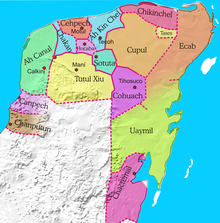Bad luck (noble family)
Pech is the name of a post-classical royal dynasty of the Maya from Yucatán . The family continues to the present day.
history
Naum Pech , a relative of the Cocom from Mayapán , who ruled as Halach Huinik from 1470 in Motul , the capital of the principality named after his gender ( Mayathan : cuchcabal ) Ceh Pech , is considered to be the founder of the dynasty .
Similar to the Tutul Xiu , the Pech cooperated with the Spaniards early on, but not consistently, and at times even provided auxiliary troops against still free Mayan principalities, following old, grown hostilities . Nevertheless, their capital was conquered in 1538 and they lost their sovereignty. However, the Pech received the Spanish recognition of their nobility and were allowed to use the address Don , which the respective head of the family made use of. The family also retained their economic and social supremacy in their former territory.
On May 8, 1544, several members of the Pech wrote a letter to the Spanish King Charles V and drew attention to their situation. Between December 25, 1557 and January 6, 1558, Alonso Ortiz de Argueta, the Spanish governor in Yucatán, took homages from Melchor Pech from Chuburná and Francisco Pech from Conkal as representatives of their families on the occasion of Philip II's accession to the throne opposite. In 1567 the family placed the Batab in 21 of 25 places in Ceh Pech . In 1688, 15 adult members of the family were named in tax lists, but a total of 34 members were known at that time. In the 17th and 18th centuries, the Batab or the governor's office in Yaxkukul, Ixil, Motul, Chuburná and Chicxulub was each occupied by a member of the Pech family. In Ixil, the Pech also owned by far the largest real estate.
Relatives
- Bad luck , from 1470 Halach Huinik in Motul
- Nakuk Pech (1490–1562), Batab of Xulub Chen (today Chicxulub), author of the much-noticed story of Xulub Chen. (1562)
literature
- M. Charlotte Arnauld, Linda R. Manzanilla, Michael E. Smith: The Neighborhood as a Social and Spatial Unit in Mesoamerican Cities. 2012, pp. 286–303 (digitized version )
- Nikolai Grube : Maya, god kings in the rainforest. Potsdam 2012, p. 387
- William F. Hanks: Writings on Language, Utterance, and Context. 2000, pp. 249–270 (digitized version )
- William F. Hanks: Converting Words: Maya in the Age of the Cross. 2010 (digitized version)
- Ralph L. Roys : The Political Geography of the Yucatan Maya. Washington 1957, pp. 45–49 (digitized version )
- Matthew Restall: Maya Conquistador. 1998
Individual evidence
- ↑ Günter Zimmermann: Letters of the Indian nobility from Neuspanìen to Karl V and Philip II around the middle of the 16th century. 1970, p. 32ff (digitized version )
- ^ Raúl Casares G. Cantón, Juan Duch Colell, Michel Antochiw Kolpa, Silvio Zavala Vallado, et al: Yucatán en el tiempo. Mérida 1998 (Spanish)
- ↑ The Chicxulub crater was named after the place.
- ↑ Mayathan : Ubelil u kablail Chac Xulub Chen. ; Spanish: La Historia y la Crónica de Chac Xulub. ; English : The Chronicle of Chac Xulub.
